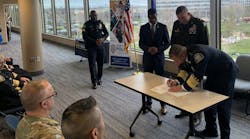- Bruce Lee
Definitions for the purpose of this article:
Consciousness - The state of being aware of our full existence.
Subconscious - Operating in the mind beneath or beyond consciousness.
Unconscious - Operating without awareness. (How many of the people you train live in this state?)
For purposes of this article, I will consider subconscious and unconscious one and the same.
Under extreme stress or pain, adrenalin rushes through the body and shuts down the creative thought process. It is at this point the subconscious MUST know how to react. Training on steel targets not only teaches the conscious mind, but the subconscious mind learns at an accelerated rate.
More than thirty years ago, Jeff Cooper identified three elements of defensive pistol craft, which became the motto of the IPSC or International Practical Shooting Confederation: Speed, power, and accuracy when it suddenly becomes necessary to shoot someone. In order to preempt a lethal assault, you have to hit and hit hard to stop the fight, and you have to hit before being hit.
The power element of this equation is a function of the chemical energy encapsulated in the cartridge. The elements of speed and accuracy depend upon your skill level. In today's firearms training world one of the best ways of developing these critical skills and achieving an effective balance of accuracy and speed is by training on reactive steel targets.
As we learn more about human dynamics involved in armed confrontations, we understand that physical skills, which require conscious thought process or intellectual processing, tend to break down rapidly under high levels of stress or arousal. If our defensive skills and response are not programmed at the subconscious level, the sudden stress of a combat situation may cause us to fumble, freeze, or panic. It is in this environment that reactive shooting skills are necessary.
Reactive shooting skills that are not dependent on conscious thought process can be taught through the use of extremely short time limits (timers) thus pushing the shooter to function at the limits of reaction and response time. This can be compared to learning how to hit a ball with a bat or racket, or developing the reflexes to block a punch or kick at full speed.
Our subconscious mind can learn to reflexively control the shooting process with positive instant feedback. Automated reactive steel targets, like the Action Target bobbers, are designed and engineered with this training goal in mind.
These systems allow you to set target exposure and reaction time. They provide positive instant feedback in a couple of ways. There is instant visual feedback when the bullet impacts the static steel plate or when a moving plate falls or retracts when hit. At the same time, audible feedback is generated by the clang of the bullet on steel. Note that as we advance our skill level, waiting for audible feedback can actually slow your progression down.
The subconscious mind is capable of processing this input in mere fractions of a second. Consistent repetition in this high-speed training takes our basic marksmanship and compresses those skills into reaction time. This effectively programs our reflexes to achieve that sought after balance of speed and accuracy. Just like riding a bike, once you understand the technique, you really have to develop a feel to make it all work. Just like riding a bike, these reflexive shooting techniques are learned and retained at a subconscious level rather than at an intellectual or conscious level, so we are less likely to "forget" how to do it.
Many fellow Firearms Instructors who have been using reactive steel targets, report excellent results. Their shooters have achieved impressive levels of skills, learning to hit quickly and reliably in half the training time typically required for more conventional techniques.
Steel will provide positive instant feedback, but it will also provide a visual to critique your performance. I have personally shot on steel and improved my accuracy and speed. However, I noticed when I worked for speed, my shots where constantly to the left of the plate or popper. In my self-analysis, I was happy with my time, but my accuracy was in question (meaning, why was I favoring the very left edge of the target even though I was knocking it over?)
Well, there were a couple of reasons. Even though I had both eyes open, I am left eye dominant. This could pull me to the left. I was also most likely shooting too fast for my skill level. So here is what I did: I made sure my grip was consistent and wrist locked. (Note: If you are not consistent with your grip, you can change the impact of the bullet on the target.) I shifted my vision off center mass to favor slightly to the right on the target and I slowed down just a little; this improved my center mass hits greatly.
My point here is to tell you just because we knock plates or poppers over doesn't mean we are doing the best we can. We need to constantly evaluate our techniques and make adjustments not only with our students, but also with ourselves. Steel provides us with a means of doing this rapidly and accurately. Mr. Bill Jordan of the Border Patrol left me with a memorable quote, "Fast is fine, but accuracy is final." This may be worth remembering for you too.
Coaching on steel is critical for both students and instructors. So try to evaluate your performance every time you shoot. This will help you to perform better, but it will also help you to coach your students.
For those of you who may be interested in a more scientific approach to my thoughts, you may find the research that has been done on developing the Neural Pathway by going to www.brains.org, a very interesting web site (linked below). To summarize some of the research about subconscious effects of conscious training often referred to as "muscle memory" by instructors, one must understand this training develops an enlarged pathway or can even create a new neural pathway. The larger the pathway or the more frequently the activity is done, the faster the activity can be performed until it reaches the minimum human bio-mechanical limit imposed by the chemical and electrical processes that occur in the brain and then along the nerves and into the muscles.
The human brain creates and enlarges neural pathways based upon usage. Therefore, practicing a particular activity creates direct neural pathways for the activity and that activity can be performed more quickly than if the activity is done infrequently.
In my opinion, at distances near contact to ten yards, the brain responds to auditory stimuli faster than it responds to visual stimuli. However, at distances beyond ten yards the brain will react faster to visual stimuli than to auditory.
The learning theory states the shorter the time between the stimuli and the objective or message, the faster the learning happens.
Similarly, the controversial issue of the death penalty lacks a learning time between action and consequence. One argument made against the death penalty is that the average time between trial and sentence is twelve (12) years. Therefore, it takes so long that there is no societal learning and thus little deterrents. Though this may not be a deciding factor, it is one argument that is made by opponents of the death penalty.
Well what does all this mean? I believe the research supports my conclusion that training on steel is a very effective and efficient way to train. The stimulus to which the shooter responds is both visual and auditory; this trains the shooter to act quickly when attacked. The visual of shooting steel is quite likely to be what an officer experiences during an attack if auditory exclusion and tunnel vision occurs.
The combination of both visual and auditory stimuli from steel is much faster than the feedback you get when shooting on paper or cardboard targets. Whichever type of target is used, the shooter must practice frequently and with enough repetitions to create or grow the neural pathways to the point that he can act at or near his bio-mechanical limits.


